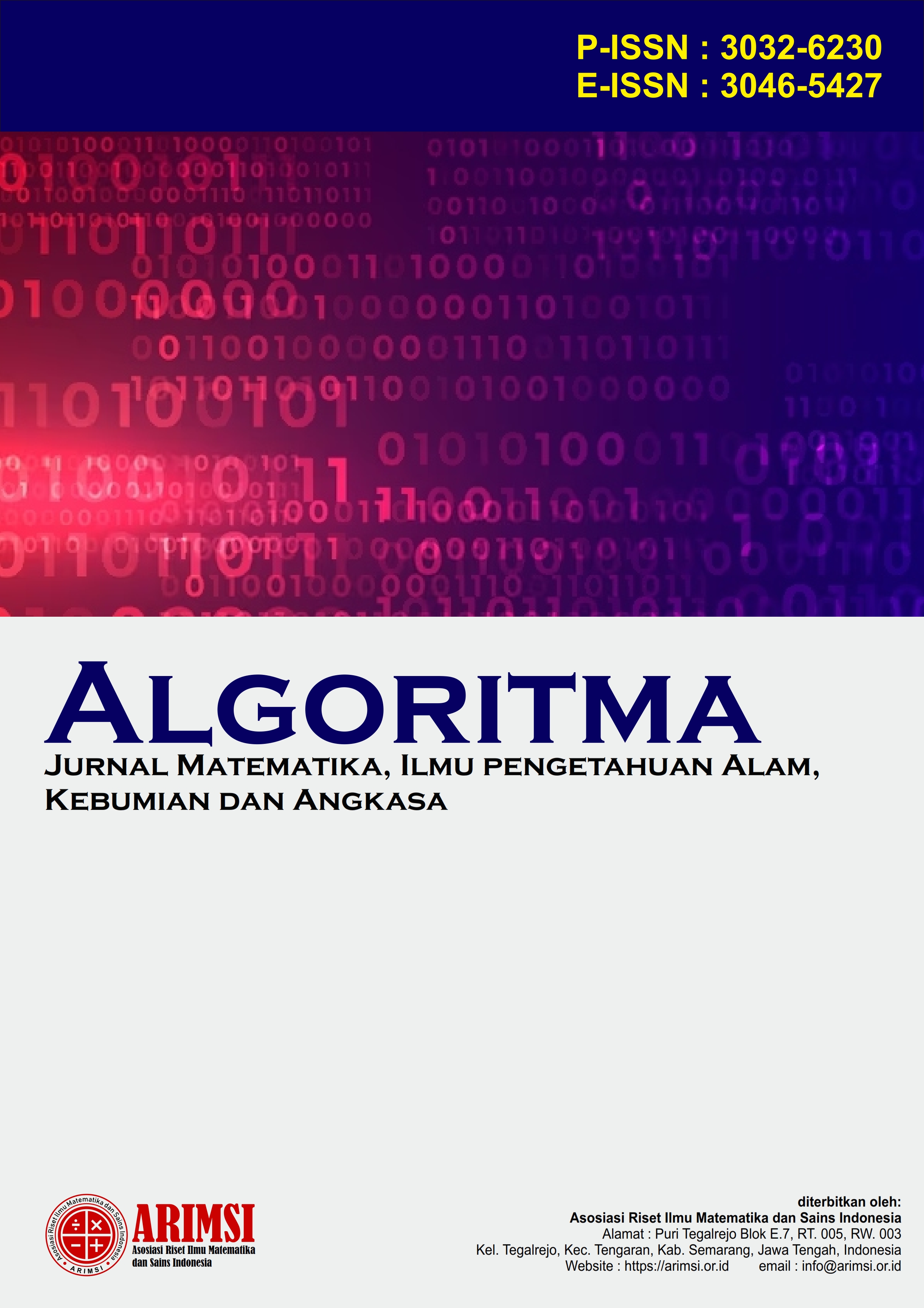Analisis Kemampuan Pemecahan Masalah Matematis Siswa Ditinjau dari Perbedaan Gender
DOI:
https://doi.org/10.62383/algoritma.v2i5.178Keywords:
Gender, Mathematics, Problem SolvingAbstract
Students need to have mathematical problem-solving skills to solve mathematical problems both in school and in real life. But in reality, students' mathematical problem-solving skills are still low. This study aims to analyze students' mathematical solving abilities from the perspective of gender differences, so that teachers can find the right solutions to improve students' abilities. This research is a qualitative research. The instruments used in this study are test questions and interview guidelines. The subjects of this study were three students taken from 20 students in grade VIII MTs Azzainiyah II. The subject consists of one student representing each of the high, medium, and low abilities. The results of the study showed that the mathematical solving ability of female students was better than that of male students. In the group of high-ability students, female students can meet all four indicators of the mathematical problem-solving stage, while male students can only meet the three indicators of the mathematical problem-solving stage. In the group of moderate-ability students, female students can meet three indicators of the mathematical problem-solving stage, while male students can only meet two indicators of the mathematical problem-solving stage. In the group of low-ability students, female students can meet two indicators of the mathematical problem-solving stage, while male students can only meet one indicator of the mathematical problem-solving stage.
Downloads
References
Agsya, F. M., Maimunah, M., & Roza, Y. (2019). Analisis Kemampuan Pemecahan Masalah Ditinjau Dari Motivasi Belajar Siswa MTs. Symmetry: Pasundan Journal of Research in Mathematics Learning and Education, 4(2), 31–44. https://doi.org/10.23969/symmetry.v4i2.2003
Asmara, P. M., & Puspaningtyas, N. D. (2023). Analisis Kemampuan Pemecahan Masalah Matematis Ditinjau dari Tingkat Self-Efficacy. EQUALS: Jurnal Ilmiah Pendidikan Matematika, 4(1), 7–19. https://doi.org/10.46918/equals.v4i2.979
Bariyyah, K. (2021). Problem solving skills: esssential skills challenges for the 21st century graduates. Jurnal EDUCATIO: Jurnal Pendidikan Indonesia, 7(1), 71. https://doi.org/10.29210/120212843
Davita, P. W. C., & Pujiastuti, H. (2020). Anallisis Kemampuan Pemecahan Masalah Matematika Ditinjau Dari Gender. Kreano, Jurnal Matematika Kreatif-Inovatif, 11(1), 110–117. https://doi.org/10.15294/kreano.v11i1.23601
Dina, Z. H., Ikhsan, M., & Hajidin, H. (2019). The Improvement of Communication and Mathematical Disposition Abilities through Discovery Learning Model in Junior High School. JRAMathEdu (Journal of Research and Advances in Mathematics Education), 4(1), 11–22. https://doi.org/10.23917/jramathedu.v4i1.6824
Fatimah, M., Nurhidayah, M., Ahmad, H., Febryanti, M., & P., M. A. (2019). Effect of Motivation and Gender on Problem-solving in Student Mathematics. 227, 101–104. https://doi.org/10.2991/icamr-18.2019.26
Kurniawan, A., Ihwayudin, & Permata, R. A. (2021). Analisis Kesalahan Siswa Dalam Menyelesaikan Soal Cerita Segitiga Berdasarkan Prosedur Polya. Jurnal Ilmiah IKIP Mataram, 8(1), 127–136. https://doi.org/10.33503/prismatika.v5i1.1942
Laksono, U. B., & Pramesti, S. L. D. (2022). Analisis Kesalahan Siswa Menyelesaikan Soal Matematika Materi Bilangan Bulat Menurut Tahapan Kastolan. Circle: Jurnal Pendidikan Matematika, 2(2), 125–134. http://e-journal.iainpekalongan.ac.id/index.php/circle
Mulyati, T. (2016). Kemampuan Pemecahan Masalah Matematis Siswa Sekolah Dasar. EDUHUMANIORA: Jurnal Pendidikan Dasar, 3(2), 1–20.
Pratiwi, D. T., & Alyani, F. (2022). Kemampuan Pemecahan Masalah Matematika Siswa Kelas V SD Pada Materi Pecahan. Journal for Lesson and Learning Studies, 5(1), 136–142. https://doi.org/10.23887/jlls.v5i1.49100
Sari, D. N. O., Mardiyana, & Pramudya, I. (2020). Gender differences in junior high school students’ mathematical connection in geometry. Journal of Physics: Conference Series, 1613(1). https://doi.org/10.1088/1742-6596/1613/1/012069
Septian, A., Ramadhanty, C. L., Darhim, & Prabawanto, S. (2021). Mathematical Problem Solving Ability and Student Interest in Learning Using Google Classroom. Proceedings International Conference on Education of Suryakancana, February, 155–161.
Septian, A., Widodo, S. A., Afifah, I. N., Nisa, D. Z., Putri, N. P. K., Tyas, M. D., Nisa, R. H., & Andriani, A. (2022). Mathematical Problem Solving Ability in Indonesia. Journal of Instructional Mathematics, 3(1), 16–25. https://doi.org/10.37640/jim.v3i1.1223
Setiyani, S., Fitriyani, N., & Sagita, L. (2020). Improving student’s mathematical problem solving skills through Quizizz. JRAMathEdu (Journal of Research and Advances in Mathematics Education), 5(3), 276–288. https://doi.org/10.23917/jramathedu.v5i3.10696
Shute, V. J., Wang, L., Greiff, S., Zhao, W., & Moore, G. (2016). Measuring problem solving skills via stealth assessment in an engaging video game. Computers in Human Behavior, 63, 106–117. https://doi.org/10.1016/j.chb.2016.05.047
Simatupang, R., Napitupulu, E., & Asmin, A. (2020). Analisis Kemampuan Pemecahan Masalah Matematis Dan Self-Efficacy Siswa Pada Pembelajaran Problem Based Learning. Paradikma: Jurnal Pendidikan Matematika, 13(1), 29–39. https://doi.org/10.24114/paradikma.v13i1.22944
Sriwahyuni, K., & Maryati, I. (2022). Kemampuan Pemecahan Masalah Matematis Siswa Pada Materi Program LinearDwita Imannia, Jumroh, & Destiniar. (2022). Kemampuan Pemecahan Masalah Matematis Siswa Pada Materi Program Linear. Inomatika, 4(1), 19–30. https://doi.org/10.35438/inomatika.v4i1.279. Plusminus:Jurnal Pendidikan Matematika, 2(2), 335–343.
Tarigan, I. M., Simanjorang, M. M., & Siagian, P. (2022). Analisis Kemampuan Pemecahan Masalah Matematis Siswa Ditinjau dari Perbedaan Gender di SMP N 1 Kuta Buluh. Jurnal Cendekia : Jurnal Pendidikan Matematika, 6(3), 2984–2998. https://doi.org/10.31004/cendekia.v6i3.1791
Utami, R. W., & Wutsqa, D. U. (2017). Analisis Kemampuan Pemecahan Masalah Matematika dan Self-Efficacy Siswa SMP NEgeri di Kabupaten Ciamis. Jurnal Riset Pendidikan Matematika, 4(2), 166–175. https://doi.org/10.25273/jta.v5i1.4642
Downloads
Published
How to Cite
Issue
Section
License
Copyright (c) 2024 Algoritma : Jurnal Matematika, Ilmu pengetahuan Alam, Kebumian dan Angkasa

This work is licensed under a Creative Commons Attribution-ShareAlike 4.0 International License.





